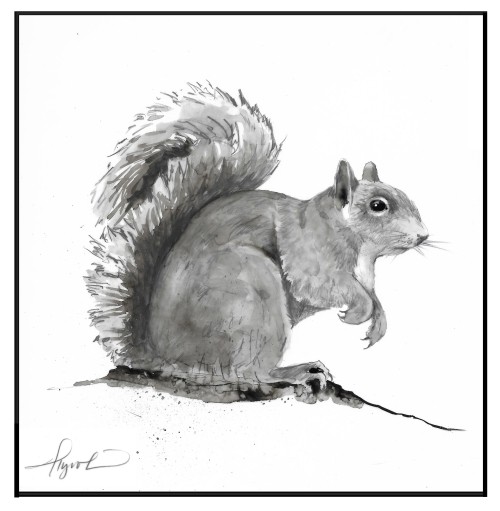
Tucked behind a stonewall on the edge of a hardwood forest, my six-year-old students and I spy on an Eastern gray squirrel (Sciurus carolinensis) as it climbs out of a tree cavity and scurries down to the ground. There is a dusting of snow. My students, bundled in vibrant snowsuits, are the only flash of color on this cold winter day. They are astoundingly quiet as they watch the scampering squirrel. We see it slide to a halt, stand on its hind legs, flick its tail, and then it’s off again until it stops to dig into the cold winter ground. As it pulls out a nut-brown acorn, I hear a buzz of excitement travel through my fellow squirrel professionals.
Gray squirrels are so common that many of us forget to notice them unless we are six. But as my students would tell you, there’s a fascinating story here. How the squirrel spends all fall collecting acorns, and can tell by a sniff and a shake if the acorn is a keeper. If the acorn has a weevil in it, the squirrel won’t bury it for winter. Instead, it will often eat it right then, consuming the nut and the added protein of the larva. This is a good plan, since an acorn with a weevil in it won’t keep for winter, rotting after the weevil has consumed most of the nut.
Another intriguing element of the story involves the squirrel’s use of deception to thwart their competition. They carry acorns, bury them, unbury them, and then rebury them in a different location, all as a means of confusing cache raiders.
Gray squirrels are master scatter hoarders. Each fall they bury hundreds upon hundreds of nuts in different locations around their territory. Studies have shown that they are pros at remembering the location of each nut, with a 95% retrieval rate. Recent research has shown that it is a squirrel’s precise spatial memory that helps it reclaim its buried bounty more than smell.
As we watched that day, it was natural to assume that the squirrel was taking advantage of the oak. But what if it was really the oak that was shaping the squirrel and its life style? These trees have their own tricks up their sleeves. Think of the acorn itself – that luscious protein that’s an irresistible invitation to a seed eater like a gray squirrel. But the prize is wrapped in a hard shell. It is an endeavor to eat an acorn, one that requires time to crack the shell and get to the meat. Because of this, squirrels can’t consume large quantities at once. The handling time is too long and would make them vulnerable to predators. And so they evolved to tuck the acorns away for leaner times. How convenient for the oak tree to have a bushy-tailed helper who buries its seed. The squirrel not only hides it away from other seed predators, it gives the acorn a place filled with soil and protection to sprout in the spring.
And then there is the way that in years like this one, all the red oak trees synchronize their acorn production across entire regions. When the forest floor is littered with acorns, squirrels up their scatter hoarding behavior, stashing away more acorns then they could ever eat. The more acorns there are, the farther away the squirrel buries the nuts from where it found them. These outlying seeds, hoarded far from the shade of their mother tree, often go unclaimed and become the next generation of oak trees.
As the first graders watched the squirrel gnawing away the shell and finally nibbling on the nut, I was watching the oak tree. I let my mammal gaze wander up its broad branches and saw another living being, not simply a passive producer providing for a consumer.


Discussion *